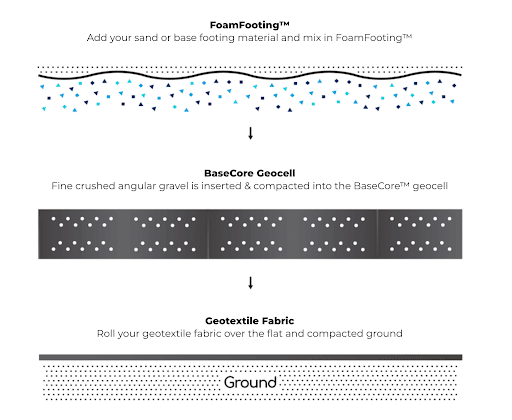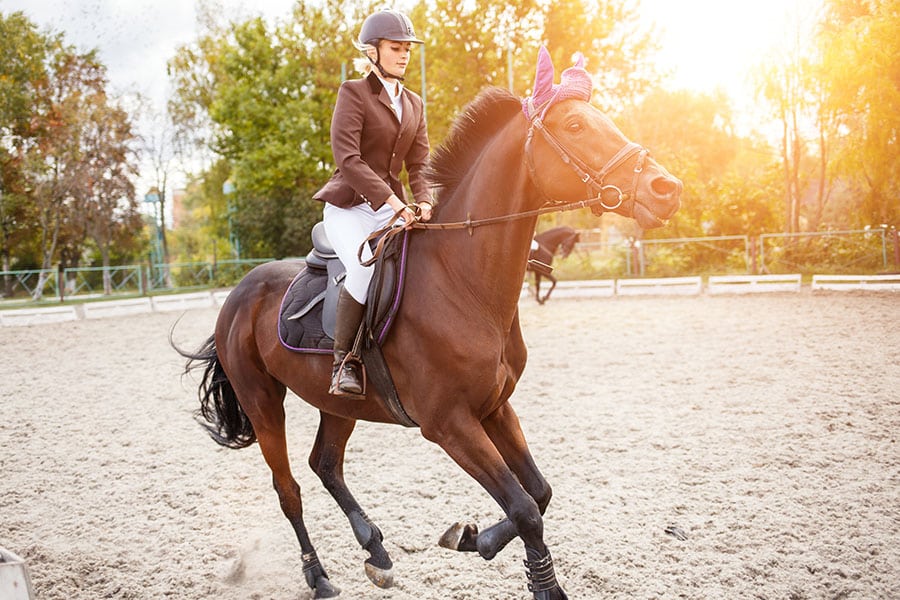Building any type of infrastructure requires a solid, stable base. Constructing a horse arena is no different, especially if you’re a competitive jumper, hunter, or dressage rider.
What you may not have heard is that high-performance training sessions don’t just come from the top-of-the-line footing blend. They come from a facility built on a foundation that supports your horse’s daily athleticism and hoove impact.
Even if your facility has a high-quality type of footing like Arena Green, your competitor is still prone to injuries.
The arena base can sink into the subgrade over time if you’re not proactive. It will create an uneven training surface no matter how many times you use an arena drag.
An arena is only as good as and will only last as long as its base, which is why understanding the requirements for a good base is so important.
Let’s explore the different sections in a riding arena, the different base layers, and what we offer.
Why an Arena Base?
Whether it’s an outdoor or an indoor sand arena, the base plays a crucial role in supporting the horses. It goes beyond just your footing materials or the type of sand your arena has.
The arena foundation gives them assurance of stable ground while training so they can perform their best. You can also trust that an arena with proper drainage won’t flood, creating pools of water to practice on.
Without a solid base, a horse could pierce through one of the upper layers and injure themselves, instead of landing on solid ground. And could lead to a career-ending injury for dressage, jumping, or another discipline.
Your footing mixture and type of arena sand won’t be effective in fixing the foundational issues of the arena. It is absolutely necessary to address the base first when building or revamping a horse facility.
What Are the Layers of a Horse Arena?
As you develop your dressage arena or competition facility, it is important to keep in mind that there are three primary layers to address: the top dressing, the subsurface, and the base.
You may be familiar with choosing high-quality footing and arena sand to provide cushion during jumps and trots. But the base lies right beneath the surface and has just as much to do with your horse’s performance as the upper layers.
Each of these has different roles and varies in importance for your equine partners’ health. We recommend speaking with a footing specialist if you have questions about how bases affect an additive’s effectiveness.
1). The Top Dressing
This section should contain mostly sand, or some manufactured material, along with a small percentage of clay and silt. Most people refer to this as the footing layer that promotes dust control and longer training sessions.
2). The Subsurface
This section is usually made of round or angular particle size sand or another manufactured material. The subsurface is between the base and the top dressing and oftentimes is simply an extension of the top dressing.
3). The Base
The base material is arguably the most important layer of the arena, as it serves as the foundation. Most bases are made out of clay and vary in size depending on the conditions around the arena.
Just as the foundation of a building is important to keep it standing for a long time, the base allows the footing product in your arena to properly support your horses for a long period of time.
Installing the Sub-Base
When building your horse arena, you will need to start with the sub-base. To develop an effective sub-base, we will need to excavate at least six inches of soil, leaving the area where you will put your arena several inches below the rest of the ground.
This process is often referred to as boxing out. This sub-base typically goes on top of compacted soil from the site.
Drainage
Before you even begin the construction process, it is essential that you understand your plan for drainage. Without efficient drains or runoffs, areas of your arena can become mushy, which can injure or inhibit your horse.
For most outdoor arenas, you will want to build a 1-2% crown in the middle so that the water flows down and out of the arena. For indoor arenas, including drains will help keep the water from harming the horse arena footing or base.
You can water your arena and not fear pooling or flooding the next training session if the base has proper drainage.
Retaining Boards
Once you box out the arena area, you will want to install retaining boards. IGK says that retaining boards “have the job of holding the footing in the arena and stopping it from migrating into the drainage outside of the arena or grass.”
These boards, which prevent the base from shifting or washing away under the surface, allow you to maintain a consistent border and prevent your grass from encroaching on your arena or vice versa.
Installing the Aggregate Layer
Once you have installed your sub-base, the next step is to install your aggregate stone layer. This is the most important part of the base that you are installing.
These stones, which should be primarily sub-angular stones, can range in size from ⅛ of an inch all the way to 1 inch.
Type of Aggregate
Usually, you will make this layer about 2-3 inches deep when building an arena. On top of the aggregate stone, you will have roughly 3 inches of stone dust.
Aggregate Availability
All of these factors will vary depending on the area where you are building and what materials are readily available and affordable. Whether or not you are building an outdoor or indoor arena also affects your choices.
What Does Performance Footing Offer?
At Performance Footing, we understand the difficulties and costs associated with building and maintaining an excellent arena. From the horse arena footing to the base below the surface, each level can quickly deteriorate or change if not properly cared for.
That’s why we have developed BaseCore and Geotextile Fabric that help maintain the quality of your footing.

BaseCore for Competition Arenas
BaseCore is an expandable ground stabilization panel for soil retention of all terrains. This product allows water to move freely without washing out the material, which protects your top soil, footing base or horse arena footing additive.
The best part about our durable geocell panels is they remove the need for a sub-base altogether. You won’t need to worry about a stone layer or installing a complicated drainage system whatsoever.
It provides significant benefits such as:
- Military-grade strength
- Reinforces the ground to eliminate further erosion
- Reduces the amount of fill needed to form a strong base
- Easy to install without heavy equipment
Geotextile for Competition Arenas
We also offer geotextile fabric for ground stabilization, weed control and more. Non-woven geotextiles have historically been used for filtration and erosion control.
If you install geotextile fabric below our BaseCore geocells, they prevent the foundation from sinking into the subgrade. This means your arena base will last much longer than other facilities without this durable support.
This fabric offers significant benefits for equestrian arenas such as:
- Prevents the mixing of a subgrade and an aggregate material
- Helps ensure the longevity of your arena
- Helps stop the formation of holes or uneven foundations caused by temperature changes
Revamp Your Equestrian Arena
If you are interested in utilizing one of our products to improve your horse arena surface or base, contact us today. We’re competitive riders ourselves and understand how to transform your riding facility into a high-performance training arena.
Give us a call at (877)-835-0878 for a free consultation to determine your arena needs.
